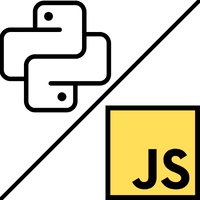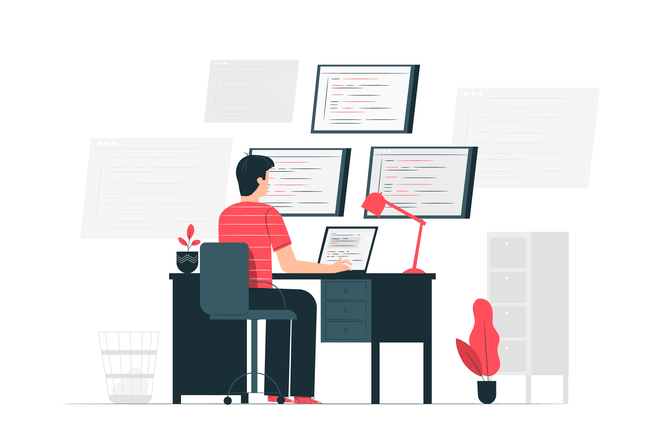Python for AI and Machine Learning related projects has been an industry favorite for years now! But with so many options available in the market, what makes Python stand out among the lot? Let’s take a deep dive to understand all of the intricacies that play a role in making it possible.
The demand for AI is booming, with an approximate market value of US$ 184 Billion that is expected to grow at a whopping 28.46% CAGR between 2024 and 2030, bringing the final value to US$ 826.70 Billion (Statista, 2024). Clearly the AI hype is not gonna dial down anytime soon!
Now with such a soaring demand for AI, it is only natural that the demand for complementing programming languages will also surge. But out of an entire ocean of options available, how did Python manage to differentiate itself and become the top choice for the development of AI?
That’s the exact question we will try to answer right now. Let’s take a deeper look at the advantages developers gain by using Python for the development of AI.
What Makes Python a Popular Choice Among All AI Programming Languages?
To understand what makes Python so good for the development of AI Models, we need to understand how the community perceives it as a standalone programming language. Once we have that information, its translation into the AI use case becomes much simpler –

[1] Easy to Read Syntax
Python’s syntax is widely known to be the most straightforward and intuitive among all the competing programming languages, this reduces the barrier to entry for anyone aspiring to become an AI developer. But Python is not just beginner-friendly, having intuitive syntax allows experienced developers to quickly grasp the situation of a project, allowing them to partake in the development at any given moment.
Debugging is another aspect of development that is greatly uplifted because of Python’s simplified syntax, as it is easier to point out mistakes and resolve them when the code is easier to comprehend.

[2] Multi-Platform Support
Python supports cross-platform compatibility, meaning developers only need to create a single codebase that can be used across all of the major operating systems with either minimal or no changes. This makes the development of a solution much more efficient compared to some other programming languages that need distinct codes for each operating system the AI model wants to operate on.
Now, in case you are wondering what operating systems Python covers with its cross-platform support, primarily – Windows, MacOS, and Linux; which is almost the entire user base. The core functionalities remain the same for a Python-based model across these platforms. However, there can be certain modules, external libraries, or system-specific tasks that might need some additional adjustments across different operating systems despite using Python.

[3] Flexible
Cross-platform support in itself is a flexibility trait, but that is not all that Python has to offer. One of the top testaments of Python’s flexibility is the fact that it allows developers to choose between OOPs and scripting, allowing code to be written across multiple programming languages and not just Python.
Developers can also mix and match various programming styles to get the most efficient output or simply use the one they are most comfortable with for the development. Some of these styles include:
- Imperative Style: It is used to define the sequence that a computer follows to execute a set of commands.
- Object Oriented Style: It includes two concepts objects and classes, where a group of similar objects make up a class. Although it has limited usability in Python due to its inability to perform encapsulation completely, it is still considered a good choice to model real-world entities.
- Functional Style: It declares what the program should do with the help of mathematical equations, which gives it a secondary title – Declarative Style.
- Procedural Style: Used primarily for sequencing, iteration, modularization, and selection. This style is considered to be the most “beginner-friendly” given it carries out tasks in a step-by-step manner.
Each of the listed styles has its own traits that can be leveraged depending on specific situations. Python allows the devs to freely switch between the styles as and when necessary.

[4] Great Community Support
Python is an open-source language with an active community. This means there are a bunch of resources available for beginners and long-time developers to take reference from, in case they feel stuck at any given point, during the development. Python has such a massive community, that most of the doubts that may arise in a developer's mind might already have a solution available on these forums.
In case there is a new issue that has not been discussed before, the community shows great interest in the questions and takes it up as a challenge to find a solution as quickly as possible.

[5] Plethora of Libraries and Frameworks
One of the primary reasons why Python is so popular among the AI/ML developers community is the fact that Python has a massive range of libraries and frameworks that the developers can easily access and use during development. This is something that is lacking in other programming languages, at least to this extent. Making the time-consuming and extensive AI development process somewhat easier as developers can get a hold of many functionalities without the compulsion of developing them from scratch, every time.

[6] Better Visualization Options
Among all the libraries and frameworks, Python consists of several visualization-centric libraries that are no less than a lifesaver for analysts. When it comes to displaying insights generated by AI… the outputs generated, although structured, are in large volumes. Without proper data visualization practices, translating the observations into insights will be quite the challenge.
Matplotlib is one of the most renowned names when it comes to Python’s visualization libraries, providing a wide variety of chart types with many customization options. But it is just one of many visualization-focused libraries that Python offers.
Various Python Libraries that Support AI development
It wouldn’t be fair to just talk about Matplotlib and not talk about some of the other exceptional AI-focused Python libraries that are used by millions of developers across the world. Here are some of the industry's favorite libraries, along with their unique offerings –
1. NumPy: This library provides support for multi-dimensional arrays and complex matrices, along with a large number of mathematical functions that can be applied to these arrays.
2. Pandas: It is popular for data analysis, pre-processing, and manipulation, and allows developers to create intuitive data structures such as series and data frames.
3. TensorFlow: Developed by Google, this library is focused on complicated numerical computations and large-scale machine learning data processing, making it the perfect choice for training and building neural networks.
4. Keras: An easy-to-use deep learning API developed in Python that is capable of running on top of other libraries such as Tensorflow, Theano, and Microsoft CNTK to provide fast and easy prototyping.
5. PyTorch: Developed by Facebook’s AI Research Lab, this open-source library is based on the Torch library and is commonly used for computer vision and natural language processing-related tasks.
6. Theano: It is an open-source numerical library for Python that builds upon NumPy and it allows complex calculations to circulate large datasets, making it a great choice for deep learning applications.
7. Scikit-Learn: Built using NumPy, SciPy, and Matplotlib, this library is popular for its data mining and data analysis capabilities. It includes multiple algorithms to perform classification, clustering, regression, dimensionality reduction, and other data analysis techniques.
8. PyBrain: Short for Python-Based Reinforcement learning, Artificial Intelligence, and Neural Networks. It claims to provide multiple algorithms for machine learning, especially those focused on neural networks along with a flexible environment to experiment and try out new ideas.
How Using Python for AI Development Compares To Other Programming Languages
We now understand the benefits Python provides while developing an AI solution, but does it effectively square up against the other popular programming languages being used for AI development? Let’s try to find an answer for that –

[i] Python Vs Java
Python has a simple and readable syntax in comparison to Java, which allows Python to orchestrate faster development and quick bug fixes. In terms of libraries, while both Python and Java offer their own sets, the Java libraries are not nearly as comprehensive as Python.
However, given that Java is a compiled language, it does have a slight edge over Python when we talk about the execution time, making it slightly better for large-scale enterprise applications operating with complicated and large databases.

[ii] Python Vs JavaScript
When it comes to machine learning, data science, and AI, Javascript’s capabilities seem nascent when compared to Python. Even the libraries that Javascript has on its roster do not seem as mature as Python. To be fair, Javascript does have a slight edge over Python in real-time data visualization-related functionalities, but Python more than makes up for it with its computational capabilities for heavy-duty AI tasks.

[iii] Python Vs C++
A code written in Python is 3 to 5 times shorter than a code written in C++, providing identical sets of instructions. This is one of the primary factors as to why Python enables rapid development and testing, which comes in handy for AI development. While C++ does have access to libraries such as TensorFlow, NumPy, Pandas, and others, these libraries were originally made for Python.

[iv] Python Vs R
R is an excellent choice for statistical computing and visualization-related tasks but its use cases are relatively situational when compared to the broader use cases of Python for the development of AI. The same trend expands in R’s learning curve, where it may become troublesome for developers who want to focus on other fields outside of statistical analysis.

[v] Python Vs Other AI Programming Languages
Some additional programming languages like Haskell and Julia, have been getting a lot of traction in the AI development industry lately, so it’s only fair that we compare them with Python as well.
First off – Julia has shown some promising results in terms of performance and its steadily growing ecosystem is making it a great contender for high-performance AI solutions. However, it does not have the quality and range of tools that Python can offer, which scrapes away a lot of the development efficiency right now.
As for Haskell, the functionality and performance are top-notch, but it is a complicated programming language. Python’s simplicity makes it more beginner-friendly. Inspiring new developers to try their hands on Python first, and in most cases, making it a staple for their future practices.
Consult Our Python Experts For Free!
Python Supporting AI Across Industries
Python has become a key player in the development and implementation of AI across various territories of the global market. The various benefits of Python are branching out to multiple Industries that harness the capabilities of AI, including –

[a] Healthcare
- Medical Imagery: Python libraries like OpenCV and Tensorflow use computer vision and machine learning technologies respectively to evaluate medical imagery and help in diagnosis.
- Medical Predictions: Libraries like Numpy and Pandas allow AI models to predict the outcome of a patient’s treatment based on specified metrics. It can be used on a larger scale to predict disease outbreaks in certain situations.

[b] Education
- Personalized Learning: Machine learning models evaluate a student’s strong and weak areas based on their performance and curate a course accordingly to help them have a consistent grasp of all topics.
- Course Optimization: Python can also be leveraged to analyze the collective performance of students across a class and evaluate if certain areas are too easy or difficult for the students to understand. This data can be further used to revise the course to provide the students with an optimal learning experience.

[c] Real Estate
- Property Valuation: Python is used to leverage machine learning that allows AI models to evaluate the price of a property based on several metrics that include a mix of current statistics and future predictions.
- Virtual Tours: 3D modeling Libraries such as Blender to create virtual environments for a given property. In most cases, a Python API is present for easy collaboration, along with the availability of scripts that can automate the creation and manipulation of these 3D models.

[d] E-commerce
- Recommendation Engines: Python has multiple libraries that can analyze customer behavior and recommend products that they might have a higher probability of purchasing. The model can also highlight any relevant discount offers that might be ongoing.
- Inventory Management: As discussed previously, Python libraries such as Pandas and NumPy enable predictive capabilities that can provide a heads-up of the upcoming demand for each inventory item, which can be referred to while making the next batch of orders from various manufacturers.

[e] Travel
- Optimal Routing: Python libraries can access Google Map functionalities to analyze all the possible routes to the destination and recommend the most optimal choice based on various factors such as traffic, road obstructions, weather conditions, etc.
- Travel Itinerary Recommendations: AI can flesh out an entire travel plan for the users based on the data of their personal preferences and the availability of various places/activities.

[f] Transportation
- Autonomous Vehicles: Python plays a crucial role in the development of libraries that are used to train autonomous vehicles how to navigate through the roads all around the world.
- Predictive Maintenance: As the autonomous concept is becoming more and more popular in the shipping industry, it has become really important to install AI models to monitor the vitals of a vehicle and launch maintenance protocols on time to avoid any issues while the vehicle is on the job.
Challenges With Implementing Python For AI Development
While Python has a bunch of really useful benefits and it triumphs over almost every other programming language available due to its vast range of libraries and ease of use, there are a few points that you should consider before starting with a Python AI project –

[A] Performance Issues
Being an interpreted language, Python’s computational efficiency is slightly worse than some of the other programming languages, such as Java and C++. This can be considered an inconvenience when you are trying to work on a machine learning or deep learning application that necessitates the processing of huge datasets.
However, this limited performance can be tackled by implementing certain techniques called parallelization and just-in-time compilation. Here’s what they do –
- Parallelization – It distributes the computation tasks across various cores or processors to speed up the execution time.
- JIT Compilation – It translates Python’s code into machine code during runtime which massively improves the performance.

[B] Scalability
Python is typically used on a single machine which limits its scalability in complicated and distributed environments. To tackle that, libraries like Dask and PySpark are introduced that enable distributed computing. However, these libraries are not as mature right now and can add an extra layer of complexity to the project, something that conflicts with the core value of Python.

[C] Integration and Deployment
Python does not have the strongest enterprise support which makes the deployment of Python-based machine learning models into the final environments more complicated compared to other programming languages. To handle these challenges, developers may have to create a few custom solutions to enable seamless integration of Python with other platforms, this however, will yet again increase the complexity of the solution.
Conclusion
While there are several programming languages available for the development of AI models, Python has consistently proven itself to be the top choice among developers. So, if you are looking to develop an AI model for your business, the choice of programming language should be a no-brainer for you. Just like the choice of a development partner! If you want a partner who understands the intricacies of translating a business requirement into a fully functioning AI model, that streamlines your business bottlenecks and improves the returns from your revenue channels, then your dream team is just one meeting away!
Schedule a Free Call With Our Experts!




.png)
.png)
